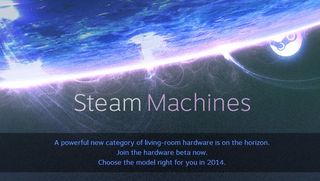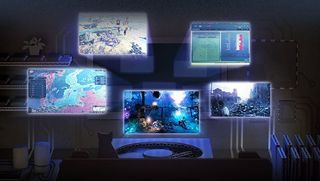Demystifying the Steam Machines
The recent announcement of SteamOS all but confirmed an impending reveal of Steam Box, Valve's long-rumored gaming machine. That reveal has come to pass--and it turns out Valve's hardware isn't so much a box as it is a series of "Steam Machines" spanning a range of technical specs, performance, and prices. But why, and what, exactly, does that mean for you?
If we're just talking about SteamOS PCs with tiered performance and pricing (which may or may not be the case), what's the point? PCs with various prices and performance ratings are readily available right now (sans SteamOS, of course). Surely slapping on some Valve branding isn't going to suddenly revitalize PC sales, which have been declining year over year for, oh, half a decade.
To understand the motivation behind all this, I think we need look no further than the values that Valve holds dear, and how those differ from what is really its biggest competitor here: Microsoft. Gabe Newell, Valve's co-founder and public face, has publicly decried the direction Microsoft has gone in the past few years, specifically its transition from an open platform toward an increasingly closed one. Now, the let's dissect what that means.

In a closed platform--think gaming consoles or Apple's iPhone--the platform creator has complete control over the content that can be accessed through its device. Obviously, this makes some business sense, as Newell explains during his presentation at LinuxCon 2013: "If you didn't like competing with Google, you just didn't let them ship on your device, or you could determine how often they could update. You could have a lot of control over things like pricing and other characteristics and that was a very seductive opportunity."
Sure, in that quote he uses the example of Google, but in the subtext, he's talking about Valve's relationship with Microsoft. What if Microsoft decides that, as a way to promote its own Marketplace efforts, it throws up roadblock after hurdle to suppress Steam? That'd be very bad news for Valve.
Compare that to an open platform--Linux, and by extension SteamOS--where if you, the user, stumble upon some breakthrough innovation, you can immediately implement it into the technology. There's no need to obtain a costly license to improve something or make a content patch available to the public. You can just do it. But doesn't that freedom mean you could also really mess things up? Sure, just as much as you can alter text on Wikipedia to claim that Newell is really into furries--but some always-watching eye will catch and eliminate that alteration fairly quickly. The benefit of open platforms is that by opening the floodgates to everyone, it'll allow for innovations that would otherwise be blocked out by closed platforms.

Valve places a lot of stock in that openness, which makes sense considering some of its most successful properties were born out of user-created content--mods and the like that just couldn't exist in the console space. As more and more platforms, Microsoft included, take a walled-garden approach to content, more and more innovations are prematurely killed along the way. Valve seems to be putting its future in the hands of its users, and it's betting that move will pay off.
Sign up to the GamesRadar+ Newsletter
Weekly digests, tales from the communities you love, and more
"The distinction between a content creator and a content consumer will get blurrier and blurrier," Newell says. "Just to be really concrete about that: Valve, we're kind of a cocky company. We like to think we can compete with any company in the world. But the one entity we wouldn't ever want to compete with is our own users. They've already outstripped us spectacularly. You can't compete with them once you give them the tools that allow them to participate in the creation of the experiences that they find are valuable."
That's the value Valve places in SteamOS--its openness, its ability to give users all the tools necessary to define what types of gaming experiences are important to them. Which brings us back to the Steam Machines. What role do they play? Without Friday's announcement--the missing piece of the puzzle--it's hard to say with any certainty just yet. But their most obvious purpose is to get SteamOS into the homes of users.

By partnering with manufacturers, Valve's now giving you a choice: you can pick up a PC with a Windows pre-installed (adding an additional $100 to the overall price), which is perhaps a less-enticing option now that you've heard complaints about Windows 8. Or you can get a gaming PC (one that likely looks like a set-top box or console as to look nice on your entertainment stand) that runs on the totally-free SteamOS. Your decision will largely come down to how much weight the Valve name carries.
Of course, SteamOS presents some challenges of its own. It'll be tough to convince people to install Linux on their machines, even if Valve holds their hand via an intuitive interface. And, if you're planning on playing games directly from a Steam Machine, that means the developers of said games must first port them to Linux, which creates the old chicken and egg scenario. Developers likely won't spend resources on ports if SteamOS has a tiny install base, and that install base won't grow without games.
The common presumption about Valve's final announcement tomorrow is that it will have something to do with a controller. I'm not so sure. More likely, that announcement will move to address the serious hurdles Valve now faces in both getting gamers to adopt SteamOS and getting big players in the game publishing world to support the operating system.
How hard could that be?
You know that kid at parties who talks too much? Drink in hand, way too enthusiastic, ponderously well-educated in topics no one in their right mind should know about? Loud? Well, that kid’s occasionally us. GR Editorials is a semi-regular feature where we share our informed insights on the news at hand. Sharp, funny, and finger-on-the-pulse, it’s the information you need to know even when you don’t know you need it.
Ryan was once the Executive Editor of GamesRadar, before moving into the world of games development. He worked as a Brand Manager at EA, and then at Bethesda Softworks, before moving to 2K. He briefly went back to EA and is now the Director of Global Marketing Strategy at 2K.

"30 years of history reside in our tape backups": PlayStation's building a game preservation mineshaft vault with 200 million files going back to a 1994 build of PS1 JRPG Arc the Lad

The other big Soulslike out this week has some Bloodborne and Dark Souls 3 in its combat, dev says, but "we would rather call AI Limit an action RPG"










